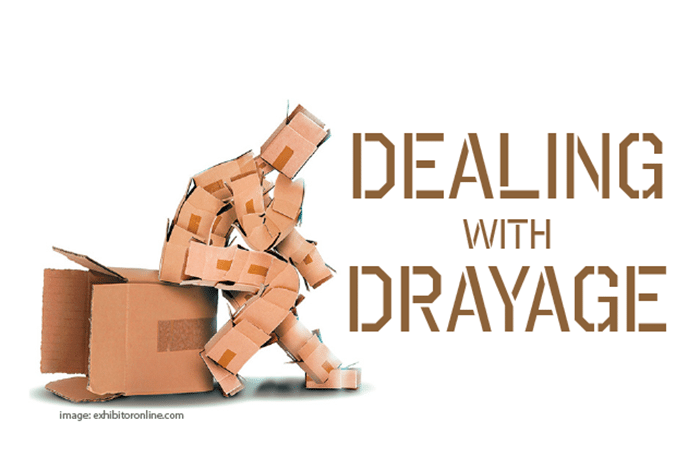In the most simplistic terms, drayage is the act of transporting something a short distance and the associated charges and fees.
In trade show terms it means that the fees you pay cover moving your goods from the loading dock to your exhibit booth, removal of the empty crates before the show, storage of your crates/boxes during the show, the return of these items at show close, and moving your packed items to the loading dock.
Seems simple enough, right? Wrong.

Drayage is one of the most complicated concepts to understand and to account for when building out your trade show budget.
More than ten years ago I realized that although I could say the word, I couldn’t articulate what it meant to my colleagues in a way that would make sense to them so I decided to write a presentation about it. I used humor and visual examples to really get to the crux of the matter.
Today, I’m sharing the key concepts with you and how you can minimize the impact drayage has on your overall show budget.
Show management assigns “target” dates to each exhibitor for their trucks to arrive and unload at a show. This helps regulate activity on the docks and gives everyone the chance to unload their equipment.
Trucks that arrive off-target only get unloaded AFTER all on-target trucks. If your truck arrives off-target, you will likely incur heavy upcharges for unloading during overtime (think 25% or more) and your trucking company will likely charge you for wait time as well.
The amount charged for drayage is based on a contract between show management and the drayage company (usually a labor union). You can negotiate your drayage costs, so be sure to be in touch with the show decorator and see what you can negotiate. You have nothing to lose and maybe you’ll even save some dollars.
Drayage is calculated by weight in CWTs (an increment of measure for freight that is based on 100 lbs). To figure out how much drayage you will have to pay, multiply the number of CWTs for a package by the standard rate provided by the material handling company found in your exhibitor kit.
Keep in mind, all packages are rounded up to the next 100 lbs. (ex. 201 lbs. of freight are considered 300 lbs. or 3 CWTs) and most drayage companies charge a 200 lb. (2 CWT minimum).
Let me give you an example. I used to work for a manufacturer of heavy machinery. A single machine might weigh 3,748 lbs. which would equal 38 CWTs. A show might offer machine pricing for drayage at $37.50 CWT. So, the equation looks like this:
38 CWTs x $37.50 = $1,425
But because the machine came in several crates, I needed to account for the following as well:
Crate #2: +1041 lbs. (11 CWTs x $37.50) = $412.50
Crate #3: +397 lbs. (4 CWTs x $37.50) = $150.00
Crate #4: +352 lbs. (4 CWTs x $37.50) = $150.00
Crate #5: +572 lbs. (6 CWTs x $37.50) = $225.00
The total drayage on-target for this single machine would run approximately $2362.50. YIKES! Now multiply that out by any number of machines and you’re talking 10’s of thousands of dollars before you do anything but get the machines from the loading dock to your booth.
The example above uses machine rates which are typically lower than “special handling rates”. What if you send in a teeny tiny box? Something that weighs only a few lbs.?
Special Handling Rates can be double that of machine rates. In this example that would mean that the rate would be $70.00 per CWT. Remember your teeny tiny box will be rounded up to 100 lbs., there’s likely a 200 lbs. minimum CWT so your box could cost $140 in drayage plus additional fees for off-target.
If you have multiple small shipments, your budget will go through the roof before you even start the show.
My best advice to you to manage your trade show budget – is to manage your drayage by doing the following things:
- Minimize unnecessary shipments – less is more.
- Gang your shipments by skidding if possible so that you can maximize your CWTs.
- Coordinate and plan your shipments to go to the advance warehouse or make your target date.
- Ship using a qualified trade show shipper who understands the ins and outs of trade show deliveries.
- Do not ship via FedEx/UPS (they usually can’t deliver on target).
- Carry small packages from your hotel.
- Stay on target.
Tune in again next month when I’ll talk about shipping. Ahhh freight!
 Sarah Markfield’s first job out of college was working for a firm in England that didn’t know what to do with the “Yank” that turned up on their doorstep. She was quickly assigned to manage an event in Geneva, Switzerland because she could speak French. Trade shows and events have taken Sarah all over the US and Europe. Today she manages customer communications and social media for a large print technology manufacturer and continues to work on trade show messaging, brand compliance and external communications including PR and social media.
Sarah Markfield’s first job out of college was working for a firm in England that didn’t know what to do with the “Yank” that turned up on their doorstep. She was quickly assigned to manage an event in Geneva, Switzerland because she could speak French. Trade shows and events have taken Sarah all over the US and Europe. Today she manages customer communications and social media for a large print technology manufacturer and continues to work on trade show messaging, brand compliance and external communications including PR and social media.











